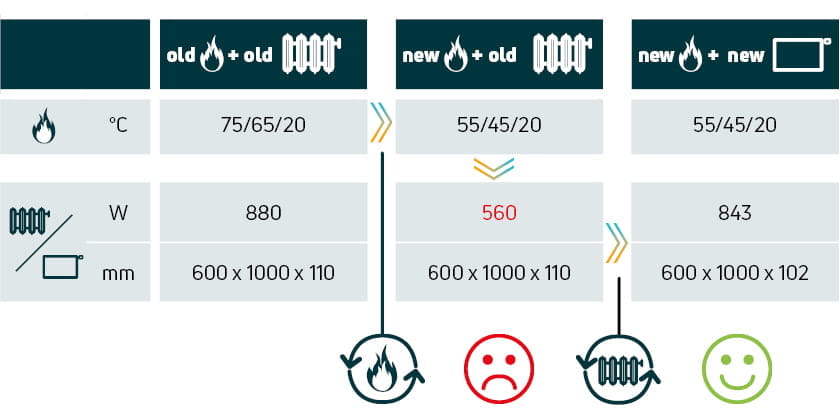- Renovation
- Radiators
- Insights
- Hydronic heating
- Energy saving
Emergency boiler repair? An opportunity in disguise!
New boiler? Don't forget the radiators.
Any HVAC professional knows that in order for a heating system to run efficiently it must be considered as a whole. Only when the individual components that generate, distribute and emit heat are fully coordinated, can the heating system function properly. So when a new boiler is installed, the distribution and heat emitters should be reviewed as well. Since radiators are still the most commonly used heat emitters, new radiators make the perfect renovation duo with a new boiler for the optimal functioning of the heating system.
Especially in properly insulated buildings an emergency boiler repair or replacement is a great opportunity to switch to a low temperature heating system. Low temperature heating significantly reduces energy consumption, which saves money and reduces emissions. That’s a win-win for the end user and the planet. Low temperature heating can also be installed in poorly insulated buildings. However, in this case, the radiator output must be increased to guarantee indoor climate comfort.
Find out more about low temperature heating
Low temperature radiators
As the overall success of a new heating system depends on good planning and a professional installation, HVAC planners and installers play a key role in the transition to low temperature heating following an emergency boiler repair. Considering old radiators were designed for high system temperatures, this includes the switch to compatible heat emitters such as modern low temperature panel radiators or fan convectors. Thanks to modern heating technology, these provide the required heat output and ensure optimal indoor climate comfort. To easily calculate the heat output for any of our radiators, simply select it in our heat output calculator and enter the parameters applicable to your project.

Calculation example comparing the heat output of an old steel radiator with a modern Plan Compact panel radiator following a boiler replacement. Modern heat sources operate at lower system temperatures for improved energy efficiency. Since the old radiator isn’t able to provide the required heat output at lower system temperatures, it must be replaced with a modern radiator which can generate the necessary heat output with almost the same dimensions.
Want to learn more about the developments in heating technology? Contact us to receive a copy of our renovation brochure.
Heat pump paired with radiators
One of the advantages of low temperature heating is the fact that it can be combined with various heat sources. While it’s perfectly possible to use a condensing gas boiler, you can also switch to renewable energy with, for example, a heat pump. Since radiators are a great match for both boilers and heat pumps, home owners are free to choose their energy source and don’t necessarily have to invest in a heat pump right away. When low temperature or ultra-low temperature radiators are installed, the heating system is ready to transition to renewable energy at any time.
Find out more about the combination of a heat pump and radiators
Hydronic balancing after an emergency boiler repair
Before running the low temperature heating system, it’s important to make sure that all radiators are supplied with the necessary amount of warm water. Heating systems that are not balanced hydraulically won’t be able to supply enough hot water to the radiators furthest away from the circulation pump, while the radiators near the pump will be oversupplied. This increases both energy consumption and heating costs and decreases indoor comfort, all of which we are just trying to avoid by installing a new heating system. With the right thermostatic radiator valves, hydronic balancing is a piece of cake. A well-balanced modern heating system in a properly insulated building can help to save up to 30% on energy consumption.
Discover how low temperature heating can help save up to 30% energy use

